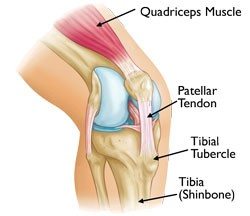Named after two surgeons who first described it, Osgood Schlatters Disease (OSD) is an apohysitis of the tibial tubercle. The patellar ligament attaches to the tibial tubercle and excessive repetitive loading results in inflammation and swelling of this bone. This painful lump just below the knee is most often seen in young adolescents or children who participate in sports and who have high training volumes.
The thigh bone (femur), shin bones (tibia and fibula), and knee cap (patella) form the knee joint which is the largest joint in the body. Contraction of the quadriceps muscle on the front of the thigh straightens the knee. The quadriceps muscle attaches to the tibial tubercle through the patella via the thick patella tendon.
The tibial tuberosity is separated from the rest of the tibia by a growth plate in adolescents. When the child is active, the quadricep pulls on the tibial tuberosity. When there is repetitive contraction and lots of impact on the legs the tuberosity can begin to inflame the growth plate and cause pain.
Half of cases of OSD have an associate precipitating trauma to the knee but mostly it is accepted that it is an overuse injury caused by repetitive microtrauma.
Children and adolescents are skeletally immature and have special areas (growth plates) where the bones are not fused. When skeletal maturity occurs the bone fuses and becomes solid and this often results in resolution of OSD.
Signs and symptoms;
- Usually OSD presents with intense knee pain on the spot of the tibial tuberosity which may look swollen
- The pain is often exacerbated by impact activities such as running, jumping, quick changes in direction, ascending/descending stairs
- Squatting and kneeling can also cause pain
- Boys are three times more susceptible to this injury
Sinding –Larsen-Johannson Syndrome is a similar condition involving the higher part of the patellar tendon and the lower margin of the patella
- Education regarding the what OSD is and why it occurring; often too high a training load
- Relative rest for a short period to allow inflammation and acute symptoms to settle, the use of ice may be helpful here
- Addressing specific impairments such as muscle weakness, muscle tightness and biomechanical alignment issues
- Taping may be used to off load the tibial tubercle for return to sport
- Return to sport with a gradual loading programme to avoid a re-occurrence

